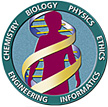 |
 |
Spanning Disciplines, Advancing Knowledge Promoting Awareness, Progress, and Applications of the Human Genome Project |
Sponsored by the U.S. Department of Energy Human Genome Program
Human
Genome News Archive Edition |
| Available in PDF In this issue... In the News Comparative Genomics Web, Publications, Resources Funding Meeting Calendars & Acronyms |
New Genome Project Tackles Sushi DelicacyScientists searching human genome data for genes and the DNA sequences that control their activity soon will have a valuable new resource, courtesy of the Japanese delicacy known as Fugu (Fugu rubripes) or pufferfish. An international consortium, led by researchers at the DOE Joint Genome Institute (JGI), has announced a collaborative agreement to sequence the Fugu genome. Although the Fugu genome contains essentially the same genes and regulatory sequences as the human, it comprises only about 400 million bases as compared with the 3.2 billion bases that make up human DNA. With far less noncoding (sometimes known as "junk") DNA to sort through, identifying biologically important regions in the Fugu genome should be a much easier task. Comparing such DNA sequences from different species is an effective method because evolution tends to conserve these regions. JGI is generating draft sequences for the Fugu genome project and applying Jazz, a new sequence assembler written at JGI. Sequence finishing and computational annotation are being done with other consortium members: U.K. Human Genome Mapping Project; Institute of Molecular and Cell Biology, Singapore; Molecular Sciences Institute, Berkeley; and Institute for Systems Biology, Seattle. Pufferfish are raised in bulk on farms in Japan, where the taste is considered addictive. If prepared improperly, however, the flesh can be lethal due to a highly potent neurotoxin present in Fugu ovaries, intestines, and livers. Eating pufferfish claims the lives of about 70 to 100 adventuresome (or unsuspecting) diners each year, most in rural areas and from fish improperly cleaned at home. It is the only food forbidden to be served to Japan's royal family. Fugu's deadly effects have caught the imagination of many authors, including Ian Fleming. Near the end of From Russia with Love, the fictional James Bond is almost killed by Fugu toxin.  Black-Spotted Pufferfish. Photo by Jeff Jeffords, http://divegallery.com Black-Spotted Pufferfish. Photo by Jeff Jeffords, http://divegallery.com
The electronic form of the newsletter may be cited in the following style: |
Last modified: Wednesday, October 29, 2003
Home * Contacts * Disclaimer
Document Use and Credits
Publications and webpages on this site were created by the U.S. Department of Energy Genome Program's Biological and Environmental Research Information System (BERIS). Permission to use these documents is not needed, but please credit the U.S. Department of Energy Genome Programs and provide the website http://genomics.energy.gov. All other materials were provided by third parties and not created by the U.S. Department of Energy. You must contact the person listed in the citation before using those documents.
Base URL: www.ornl.gov/hgmis
 Site sponsored by the U.S. Department of Energy
Office of Science, Office
of Biological and Environmental Research, Human
Genome Program
Site sponsored by the U.S. Department of Energy
Office of Science, Office
of Biological and Environmental Research, Human
Genome Program